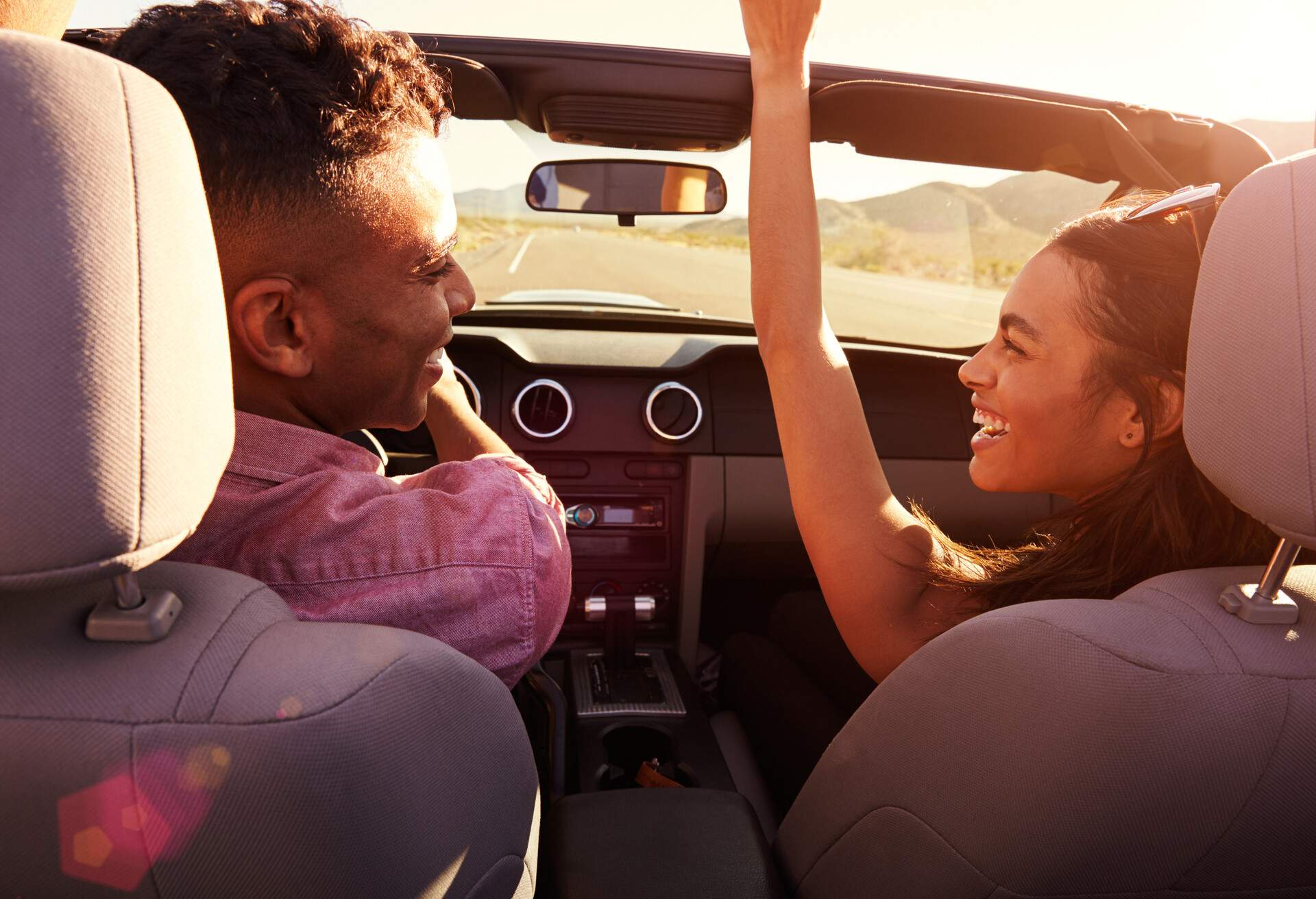Knowing the different rules and regulations for driving in the United States is important if you’re looking at hiring a car while on a trip there, so read on to find out more.
Requirements for driving in the US
The minimum age for driving in the United States varies by state. Drivers can get their full licence from the age of 16 years and 6 months in states such as South Carolina and Wisconsin, but must wait until they’re 18 years of age in states like Florida and Georgia.
When driving in the US as a visitor, holders of a UK driving licence do not need to get an International Driving Permit (IDP), as their licence is officially recognised by the US. This is possible for a maximum period of three months from the date you enter the country. If you are looking at driving for a longer period of time then you will need to get an IDP.
If you’re planning to drive in the US, you will need the following documents and items with you:
- Full and valid UK driving licence
- Valid passport (as a proof of ID)
- Proof of insurance
- Warning triangles

Hiring a car in the United States
Find out all the ins and outs of hiring a car in the US to make an informed decision for your trip.
What do you need to hire a car in the US?
If you are looking at hiring a car while in the US, it is important to research the specific requirements of each agency. Even though the minimum driving age in the US ranges between 16 and 18, most car hire companies do not hire to drivers who are under 21. You will need to have a full UK driving licence and some agencies will require you to have held it for at least a year.
You will need to show your valid passport as proof of ID, and you will need a credit card so you can pay for the deposit on the car. If you don’t have a credit card, you can still hire a car using a debit card with some of the major car hire agencies. You also need to have insurance in order to drive in the US. Liability insurance is mandatory in most US states, so make sure it is included in your hire agreement. You are also advised to purchase a Collision Damage Waiver or Loss Damage Waiver to protect yourself if the car gets damaged.
Tips for hiring a car in the US
When hiring a car in the US, look out for the following details as they might make your car hire experience much easier:
If you’re going on a long road trip and crossing the country from one side to the other, it would make more sense to opt for one-way car hire. This might incur additional drop-off fees, and you should also make sure that the agency will let you take the car across state borders by informing them of your plan in advance.
Although some car hire companies do accept debit cards as a payment method, keep in mind that most do not accept prepaid cards, Maestro or Visa Electron cards, cheques or cash.
If you’re planning on getting third-party car insurance, take a close look at the hire contract and understand what sort of insurance is already included to avoid paying twice for the same coverage.


Rules on the road in the US
Which side of the road in the US
In the US, cars drive on the right side of the road, which is the opposite side to the UK.
Road types in the US
Stop signs
When arriving at a stop sign, the car must come to a complete stop behind the white line. You must give priority to traffic on the main road. If another car is stopped at a stop sign on the same intersection, the car which arrived first has right of way once the main road is clear.
Speed limits
Speed limits vary according to each state. Generally speaking, interstate highways have speed limits that can reach up to 80mph and four-lane roads will have speed limits of around 65mph, while on rural roads you can typically drive up to 45mph. In urban areas you will find the lowest speed limit, which is 30mph. The US uses customary units to measure speed, so you will be relieved to see that speed limits are all indicated in mph.
Motorways & Road tolls
In the US you might pay tolls to drive on highways, to cross bridges and tunnels, or to use an express lane on a highway. Some states such as Arizona, Wisconsin and Idaho do not have a toll system. Each state has a different payment system for toll fees, but for the most part payment is made electronically; if you don’t have an account for automatic payment you can pay online after your trip. In some cases, you might still be able to pay in cash.
Priority & overtaking
When you find yourself at an intersection which does not have traffic lights, right of way is usually given to the car that arrived first. If two cars arrive at the same time, the one on the right has right of way. While the US doesn’t have many roundabouts, if you do find yourself approaching one, remember that whoever is already on the roundabout has right of way.
Overtaking is allowed on roads with four lanes or more, and on most roads with two lanes as long as there is enough visibility. A car must always overtake on the left. If you are on a two-lane road and a school bus stops, traffic on both sides of the road must stop until the bus leaves.
Alcohol allowance & drink driving
The limit for alcohol consumption and driving in the US for drivers over 21 years of age is 0.08%, which is the same as in the UK. If you are under 21, the limit depends on the state and varies from 0.00% to 0.02%.
Safety – Seat belts & Child seats regulations
Seat belts are mandatory in the US, but the rules vary with each state. In 19 states, including California and Hawaii, they are mandatory for all occupants of the car, while in other states such as New York and Florida seat belts are only mandatory for passengers in the front seat. Children under the age of two should be in a rear-facing seat, after which they can move to a front-facing car seat with a harness. Once they have outgrown car seats, they should be seated in a booster seat with belt positioning.
Parking
When looking for a space to park, make sure you look out for street signs giving any timing or payment restrictions. In some cities parking spots are colour-coded, but the meanings of the different colours vary depending on the location. You must always park facing in the same direction as traffic flow, and you should not park across entrances or within 10ft of a fire hydrant. Disabled parking spaces are available in most locations and are usually free for those with a disabled permit.
Fuel
There are three types of petrol available in the US: Octane 87, which is the regular type of petrol, Octane 89-90, which is a mid-grade type, and Octane 91-94, which is premium-quality petrol. Diesel is also available and can be found at most stations. You can generally pay for fuel with cash or card, and in most cases you will have to prepay at the cashier before filling the car.
Other things you should know about driving in the US
In addition to the above, here are a few useful pointers that you should know about:
- When you get to a red traffic light, you are allowed to turn right provided there is no oncoming traffic
- Interstate “freeway” exits each have a number assigned to them; these are increasing numbers, however they reset whenever you cross a state border
- If you are driving on a two-lane road and a school bus stops in either lane, traffic must stop in both lanes until the school bus drives off again
- In some states, you are allowed to use a mobile phone to talk in the car as long as it’s hands-free. Using it to text or send emails is prohibited everywhere.
- If you are pulled over by the police while you are driving, stop the car in a safe place, turn the engine off and turn on the internal light, open the window halfway and place your hands on the wheel (or on the dashboard if you’re in the passenger seat). Upon request, you may need to show your driving licence, car registration and proof of insurance. Avoid making sudden movements as these may be misinterpreted.
Driving in the US – FAQs
Yes, you can drive in the US on a UK licence for up to three months from the day you enter the country. For longer periods, you need an IDP.
The minimum driving age in the US varies by state and can be as low as 18 in New York and Michigan, and 21 for most of the other states.
In most states in the US you need to be 21 to hire a car, except for Michigan and New York where the minimum age is 18.
To hire a car in the US you need a full UK driving licence which you have held for over a year, a valid passport, and a credit or debit card.
Popular car hire locations in the US
For more car hire options, check out our partner Discovercars.com
















